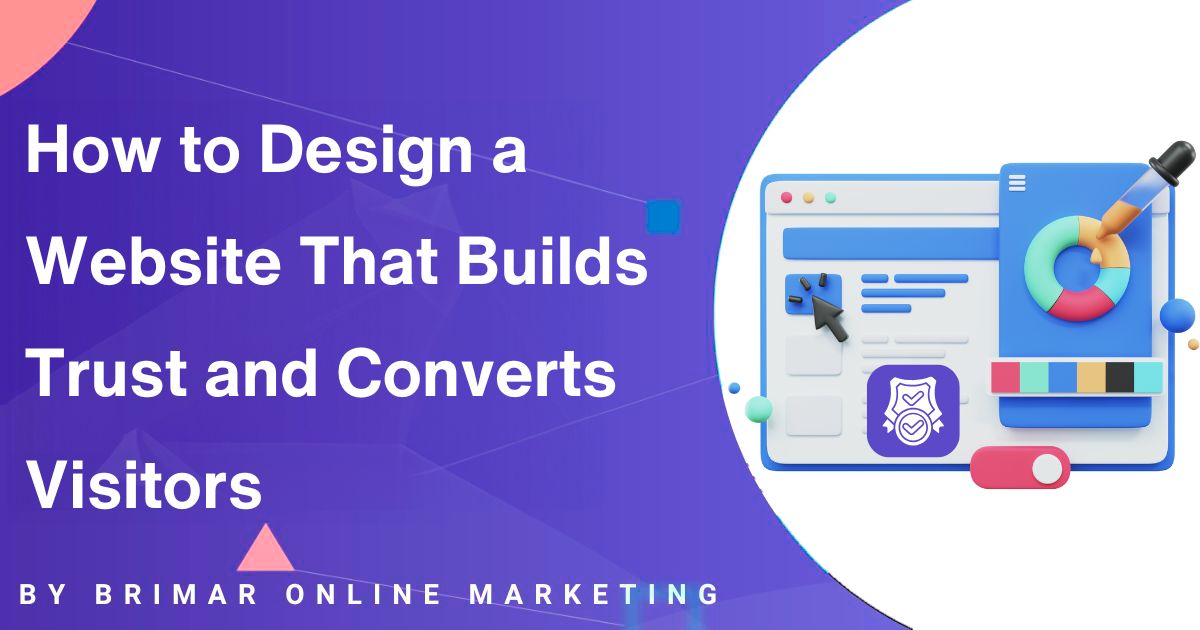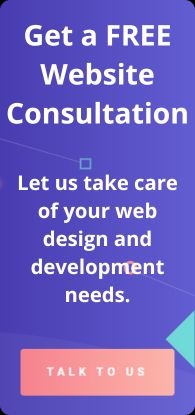
The moment someone lands on your website, they start forming an opinion.
Whether they’re a casual visitor or a potential client, what they see in those first seconds will shape what they believe about your business.
Is this a trustworthy website?
Does it feel professional?
Can they find what they’re looking for quickly?
If the answer to those is no, they’ll bounce, and you’ll never get the chance to earn their business.
That’s why smart web design isn’t just about looking good.
Let’s break down how to create a high-converting website that connects with your audience and drives real results.
Know Your Audience Before You Build Anything
Every design decision should be shaped by a clear understanding of your target audience.
Before you choose your color scheme or write a single line of text, ask: Who are you trying to reach?
Small businesses?
E-commerce websites?
Busy service providers?
Each has different expectations, needs, and pain points.
Research what motivates your ideal visitor.
What frustrates them?
What kind of experience would feel seamless for them?
The more specific you are, the easier it is to design a website that speaks directly to potential customers and keeps them engaged.
Dig into online communities.
Read reviews of competitors.
Ask questions on social media.
The more you understand your audience’s journey, the better you anticipate their needs.
You can even survey past clients to uncover what convinced them to work with you.
A clear understanding of your audience also helps you create better website content, tailor your design elements, and make your landing pages more effective.
The result is a site that feels like it was built just for them.
Get a FREE Website Consultation
Let us take care of your web design and development needs so you can focus on your business. We can handle new websites, landing pages, website redesign, and even maintenance.
Contact us today to get a free website consultation!
Make a Powerful First Impression
First impressions online happen fast.
A slow website, outdated design, or cluttered layout tells visitors they’re in the wrong place.
Your homepage should answer three questions within seconds:
- What do you do?
- How will it help me?
- What should I do next?
This entails clear headlines, a concise value proposition, and noticeable calls to action.
Highlight your most important information right away.
Don’t bury it three clicks deep.
Fast load times, intuitive navigation, and visually appealing design elements all play a role in lowering bounce rates and increasing engagement.
If your website is slow or confusing, even the most beautiful layout won’t make up for the frustration it creates.
A clean layout with contrasting colors to guide the eye helps create a positive overall user experience.
Include trust signals like client logos, brief case studies, or even a short testimonial on your homepage to boost credibility immediately.
Make Mobile Users a Priority
It’s no secret that more than half of your website visitors come from mobile devices.
If your site doesn’t work on different screen sizes, you’re giving a bad impression to many people.
A responsive design adjusts automatically to any device, offering a seamless experience for both desktop and mobile users.
- Navigation should be simple.
- Buttons should be big enough to tap.
- Text should be easy to read without zooming.
People make quick decisions.
A site that doesn’t load well on a phone tells them you’re not serious.
That’s the last thing you want.
Use mobile testing tools to ensure your mobile-friendly website performs on smartphones and laptops.
Make sure essential calls to action are visible without scrolling and optimize forms for mobile typing.
Include mobile-specific design features like click-to-call contact information, sticky navigation, and compressed high-quality images to improve loading time and reduce bounce rate.
Establish Trust From the First Click
Display visible trust signals like an SSL certificate, clear contact information, and up-to-date copyright notices.
If you collect personal information, make your privacy policy easy to find.
People need to know their data is protected.
Even small touches like a contact page with a phone number, business address, and a working contact form show there’s a real person behind the brand.
Highlight secure payment options on checkout pages.
Add recognizable security icons, especially for e-commerce websites or online stores.
Include a short FAQ about your security practices or how you handle client information.
It shows transparency and reassures even the most cautious visitors.
Communicate Your Value Clearly
Your value proposition must be clear within seconds.
What makes you different?
Why should someone trust you with their time or money?
Don’t be vague.
Don’t be generic.
Use simple, persuasive language that shows you understand the audience’s needs.
Then guide them to the desired action.
A clear call to action, “Start Your Free Trial,” “Schedule a Call,” “Download Now,” should be impossible to miss.
Use contrasting colors and whitespace to make your CTA pop without being pushy.
Every landing page should lead people to take an action.
Avoid dead ends or links that don’t serve a purpose.
Link back to your services or include a short testimonial to increase the impact.
Use Social Proof to Back Up Your Claims
People believe people.
Adding social proof builds instant credibility.
If others have trusted you and had a great experience, they will too.
Show off your success stories.
Use case studies, testimonials, and positive feedback from satisfied customers.
Mention any awards, certifications, or partnerships.
Use high-quality images of real clients, not stock photos.
Link to reviews on trusted platforms.
These trust signals make a huge difference.
Even a simple quote from a happy client can move the needle regarding trust.
Consider placing reviews across multiple pages, not just one dedicated testimonial page.
Spread the positive energy throughout your web pages.
Add High-Quality, Helpful Content
Valuable content keeps people on your site and helps them trust your expertise.
A well-maintained blog with posts that answer common questions, explain your process, or share tips builds authority.
Use high-quality content to solve problems, not just sell.
Teach.
Explain.
Give away some of your best ideas.
The goal isn’t to overwhelm.
It’s to help.
This approach also helps improve your search engine rankings.
The more your site answers real questions with depth and clarity, the more visible you’ll be in search results.
Consider including videos, infographics, and downloadable guides.
These give website visitors more reasons to stick around and share your content.
It also helps you rank for featured snippets and long-tail search queries.
Content isn’t just a blog.
Add helpful copy to product, service, and even your contact pages.
Every word counts when it comes to trust.
Design for SEO Without Sounding Like a Robot
Search engines still matter.
If people can’t find you, your perfect design doesn’t matter.
But search engine optimization shouldn’t ruin the overall user experience.
Naturally include relevant terms like web design, contact form, product pages, and landing page. Structure your website content clearly.
Use headers, bullet points, and short paragraphs to make reading easier.
Test different versions of your web pages with A/B testing.
Analyze user behavior in Google Analytics to identify drop-off points and make adjustments accordingly.
Track how visitors interact with your content.
Where do they click?
Where do they stop scrolling?
That data is gold when it comes to making your site better.
Make Navigation Effortless
People don’t want to hunt for answers.
Clear menus, logical flow, and consistent design elements keep them moving.
Think about their path.
Every click should feel natural, from the homepage to product pages to pricing to checkout.
Place your most important pages in obvious spots.
Avoid unnecessary dropdowns or complicated structures.
Design with simplicity in mind.
If users get lost or confused, they leave.
It’s that simple.
Incorporate a straightforward site map and a search bar.
These small additions help improve usability and reduce frustration.
If you have multiple service lines, break them into categories that are easy to understand at a glance.
Give every page a purpose and a destination.
Create a Friction-Free Conversion Process
A high-converting website makes the next step easy.
Whether it’s signing up for a free trial, entering credit card info, or submitting a form, every interaction should be quick and intuitive.
Keep forms short.
Eliminate the fine print.
Make sure CTAs are above the fold.
Remove distractions that get in the way of conversion.
Use color schemes and high-quality visuals that draw attention to the action without overwhelming the message.
Every page should end with a clear direction.
Test conversion flows regularly.
Identify and fix anything that might cause hesitation or confusion.
Use A/B testing to fine-tune copy, button placement, and image choices.
Every small tweak can add up to big gains in conversion rates.
Make Contact Effortless
Once someone decides to reach out, don’t make them work for it.
Place contact details in your site footer and on a dedicated contact page.
Include a phone number, email, and a short form.
Also include links to your social media profiles so they can check you out there, too.
The more open and accessible you seem, the more comfortable people will feel reaching out.
For local businesses, include a map or directions.
For service-based businesses, add a scheduling tool or an FAQ section.
Respond to inquiries quickly.
If people don’t hear back soon, they move on.
Timely responses reinforce the trust your website’s design helped build.
Use Design to Reflect Your Brand’s Values
Your website’s design should communicate who you are.
Employ visuals, writing, and design to embody your brand’s values.
If you’re relaxed and friendly, let that shine through.
Show it in your professional design and tone if you’re polished and professional.
People connect with authenticity.
A well-branded site helps create an emotional connection, not just a transaction.
Every element sends a message, from fonts to photos and icons to page flow.
Make sure that the message aligns with the trust you’re trying to build.
Use behind-the-scenes content or founder bios to humanize your brand even further.
People trust people, not just platforms.
Final Thoughts
Designing a site that earns trust and converts isn’t about flashy features or clever tricks.
It’s about being clear, consistent, and honest.
Understand who you’re talking to.
Make their experience smooth.
Show them why you’re the right choice.
The bottom line is this: good design builds relationships.
And those relationships are what drive business success.
So, remember the goal, whether you’re building from scratch or improving what you already have.
A great website doesn’t just get traffic.
It turns website visitors into loyal customers.
Every small improvement you make goes a long way.
And it all starts with trust.
We Have Delivered High Quality Websites and Our Customers Are HAPPY!
“Good quality and responsive service. Isaias is a professional person, he is always aware of the needs of his clients. He has always helped me in my projects.”
CEO

